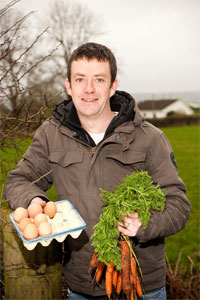Grow It Yourself - January
 I’ve tried hard to resist the charms of kale over the years, but finally, perhaps inevitably, I have succumbed. I’ve become somewhat of a kale nut. Kale suffers somewhat from a reputation problem.
I’ve tried hard to resist the charms of kale over the years, but finally, perhaps inevitably, I have succumbed. I’ve become somewhat of a kale nut. Kale suffers somewhat from a reputation problem.
If spinach is the very manifestation of the “eat your greens” horror that is imposed on us as children, then kale is even worse – all rugged and jagged - at least spinach is relatively smooth skinned. Most kale recipes involve disguising it as an ingredient – blitzing it in a soup, or boiling it down in to a stew. Given how formidable it looks, that’s perhaps not surprising.
I blame nutritionist Dorcas Barry for my new kale obsession – it was she that first convinced me to try eating kale raw, in a delicious kale salad that she was giving away on her stall at the GIY Gathering last year. In fact, it was so delicious (see recipe below), I didn’t believe it was kale.
One can’t overestimate just how good for you a raw kale salad is – super food fads come and go, but kale is the real deal. It’s loaded with fibre, vitamins A, C and K, folic acid, potassium and calcium. Per calorie it has more iron than beef and more calcium than milk. It’s considered a valuable anti-inflammatory and is high in cancer-busting anti-oxidants. I never doubted that for one minute – what I did doubt, very much indeed, was that it could be so tasty.
Kale is brilliant to grow at home. Once you protect seedlings from slugs and other critters, it’s one of those near perfect vegetables to grow – very low maintenance but very high return. And once you get the plants started, it’s a doughty survivor - kale will be providing greens right through the winter and hungry gap months, when nothing else is growing in the garden. It’s a “cut and come again” vegetable – in other words, you don’t have to wait for a head to form as you do with cabbage, but rather you continue to cut the leaves and the more you cut the more you can harvest.
Kale plants for overwintering are typically sown in spring – I sowed mine in module trays in the potting shed and planted out about 6-8 weeks later. By now they are 4ft tall and providing much needed colour in an increasingly drab winter garden.
We still have carrots, parsnips and the like to eat from the garden, but already one can imagine a situation where the kale plants will be pretty much the only source of fresh food from the veg patch.
To Do
Plan. This is the time to decide where and what you are going to grow this year. If you are just starting out join your local GIY group for advice and check out our website for handy “getting started” guides and videos. Consider building or buying raised vegetable beds. Order your seeds, onions sets and seed potatoes. Turn over the soil only if the weather is dry – if the soil sticks to your boots it’s too early for digging! “Chit” seed potatoes – put them in a container (e.g. used egg carton or empty seed tray) and leave them in a bright warm place to sprout.
Sow
In mid Feb, in seed trays and pots on a sunny windowsill indoors sow celery, globe artichokes, celeriac, leeks, onions, lettuce, tomatoes, peas, aubergines, peppers/chilli-peppers. Weather permitting outside you can try sowing broadbeans, spinach, kohlrabi, onion and shallot sets, Jerusalem artichokes, parsnip and early pea varieties.
Harvest
You may still have winter cabbage, perpetual spinach, chard, leeks, kale, cauliflowers and Brussels sprouts in your veggie patch and depending on how successful your growing/storage regime last year was, you may well still be tucking in to stores of potatoes, celeriac, carrots, parsnips, onions, cauliflower, jerusalem artichokes, winter squash, pumpkins, leeks and red cabbage.
Recipe of the Month – Kale Salad
This recipe from Dorcas Barry is taken from the 2013 GIY magazine GROW. Massaging the kale with lemon juice effectively cooks it, and makes it far more palatable while retaining its nutrient richness. It will keep for 3 days in the fridge. Serves 4.
Ingredients:
• 250kg kale
• Juice of 1 lemon
• 25g dried cranberries, chopped finely
• 25g pine nuts, roasted
• 4-5 spring onions, chopped finely
• 2-3 stalks of celery, chopped finely
• olive oil
• salt and pepper
Directions
Remove the stalks from the kale and roll each leaf before chopping in to fine strips. Place in a large bowl, add the lemon juice and 2-3 pinches of sea salt.
Massage the kale with the juice and salt until is starts to soften a little, making sure all the leaves are coated.
Sprinkle with olive oil and leave it to sit for another 10 minutes to soften further.
Before serving add the cranberries, pine nuts, celery and spring onion and stir well.
Tip of the Month – Sort your seeds
It’s a great time of the year to address those tasks that we often put on the long finger, like sorting out your seeds. Having a good seed storage regime (if that doesnt sound too nerdy) will make your seed last longer, save you money, and ensure better germination rates. Bear in mind that the storage lives for seeds listed on packets are generally for unopened seeds - the viability of seeds is cut drastically once you open the packet.
Here are three tips with that in mind:
1. tightly close opened seed packets - if they are in a foil or paper wrapper inside the packet, make sure to fold this over tightly.
2. Store the seed packets in a sealed container (e.g. a tupperware container with a tight fitting lid). You could dedicate a container to the different vegetable families, e.g. have one for legumes, one for brassicas, one for roots etc. Store the containers in a cool, dry and dark place.
3. Discard seeds that are out of date - they will only lead to lost time in the veggie patch next year.
 About GIY
About GIY
GIY is a not-for-profit organisation that aims to create a healthier, more sustainable world where people grow their own food. We inspire and support people to grow food more successfully by bringing them together to share advice, tips and ideas. There are approximately 50,000 people involved in the GIY movement in Ireland.
For more information check out www.giyireland.com
Michael Kelly is a freelance journalist, author and founder of GIY Ireland.
© GIY Ireland 2013 – all rights reserved.






There are currently no comments
Leave a comment
Not a member? Register for your free membership now!
Or leave a comment by logging in with: